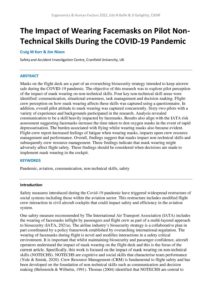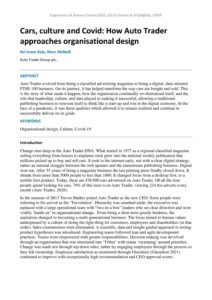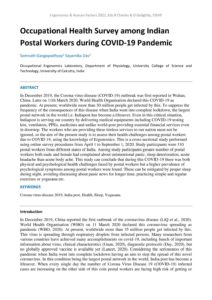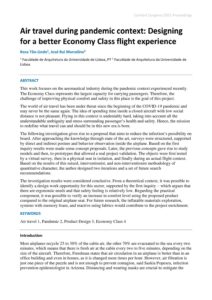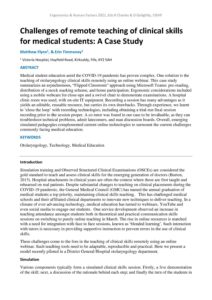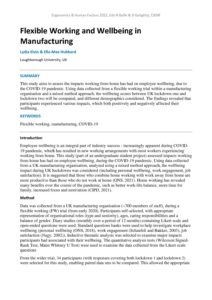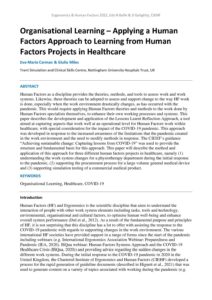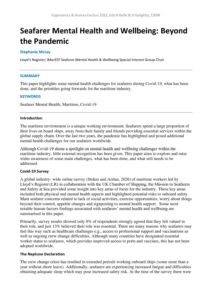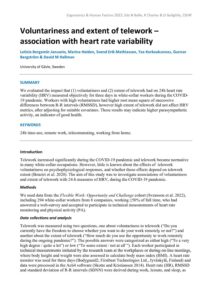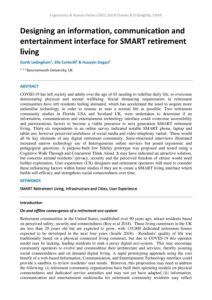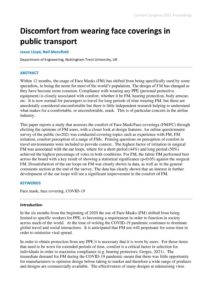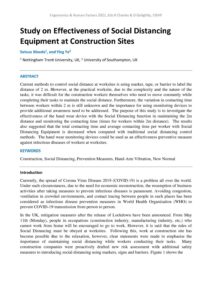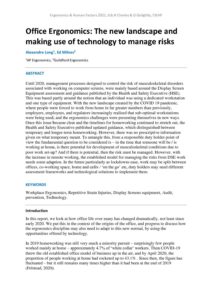Pandemic
The Impact of Wearing Facemasks on Pilot Non-Technical Skills During the COVID-19 Pandemic
| Document | Author Craig M Kerr & Jim Nixon |
| Abstract Masks on the flight deck are a part of an overarching biosecurity strategy intended to keep aircrew safe during the COVID-19 pandemic. The objective of this research was to explore pilot perception of the impact of mask wearing on non-technical skills. Four key non-technical skill areas were identified: communication, situational awareness, task management and decision making. Flight-crew perception on how mask wearing affects these skills was captured using a questionnaire. In addition, overall pilot attitude to mask wearing was captured concurrently. Sixty-two pilots with a variety of experience and backgrounds participated in the research. Analysis revealed communication to be a skill heavily impacted by facemasks. Results also align with the IATA risk assessment suggesting facemasks increase the time taken to don oxygen masks in the event of rapid depressurisation. The burden associated with flying whilst wearing masks also became evident. Flight-crew report increased feelings of fatigue when wearing masks, impacts upon crew resource management and performance. Overall, findings suggest that masks impact non-technical skills and subsequently crew resource management. These findings indicate that mask wearing might adversely affect flight safety. These findings should be considered when decisions are made to implement mask wearing in the cockpit. |
Cars, culture and Covid: How Auto Trader approaches organisational design
| Document | Author Nu’maan Kala, Marc McNeill |
| Abstract Auto Trader evolved from being a classified advertising magazine to being a digital, data oriented FTSE 100 business. On its journey, it has helped transform the way cars are bought and sold. This is the story of what made it happen; how the organisation continually revolutionised itself, and the role that leadership, culture, and data played in making it successful; allowing a traditional publishing business to reinvent itself to think like a start-up and win in the digital economy. In the face of a pandemic, it was these qualities which allowed it to remain resilient and continue to successfully deliver on its goals. |
Occupational Health Survey among Indian Postal Workers during COVID-19 Pandemic
| Document | Author Somnath Gangopadhyay and Sayantika Das |
| Abstract In December 2019, the Corona-virus-disease (COVID-19) outbreak was first reported in Wuhan, China. Later on 11th March 2020, World Health Organisation declared this COVID-19 as pandemic. At present, worldwide more than 30 million people get infected by this. To suppress the frequency of the consequences of this disease when India went into complete lockdown, the largest postal network in the world i.e. Indiapost has become a lifesaver. Even in this critical situation, Indiapost is serving our country by delivering medical equipments including COVID-19 testing kits, ventilators, PPEs, medicines and unlike world-post providing essential financial services even in doorstep. The workers who are providing these tireless services to our nation must not be ignored, so the aim of the present study is to assess their health challenges among postal workers due to COVID 19, using the knowledge of Ergonomics. This is a cross-sectional study performed using online survey procedures from April 1 to September 1, 2020. Study participants were 310 postal workers from different states of India. Among study participants greater number of postal workers both male and female had complained about unintentional panic, sleep deterioration, acute headache than acute body ache. This study can conclude that during this COVID-19 there was both physical and psychological health challenges faced by postal workers but a higher prevalence of psychological symptoms among postal workers were found. These can be mitigated by proper sleep during night, avoiding discussing about panic news for longer time, practicing simple and regular exercises or yogasana etc. |
Air travel during pandemic context: Designing for a better Economy Class flight experience
Capturing Changes in Healthcare during COVID-19 – A Physiotherapy Services Case Study
| Document | Author Giulia Miles, Eva-Maria Burford & Laura Evans |
| Abstract During the UK’s initial response to the COVID-19 pandemic, the National Health Service witnessed drastic and rapid changes to the way work was done. Not only were changes implemented at an organisational level, but at a more local level, staff across the service adapted and developed methods of coping to keep the healthcare system functioning. As a result of this, ideas and innovations that emerged during the initial response may be helpful not only in the immediate future but also in the longer term. This study applied a systems approach to explore the changes and adaptations to work in the Physiotherapy department of a large acute trust in the UK during the initial response to COVID-19 (April 2020). Using online focus groups, the changes to the work structure, challenges and aspects that worked well were explored with 26 physiotherapy staff. The qualitative data was analysed using thematic analysis to determine the common themes across the focus groups. By utilising a systems approach, a better understanding of the effect of the changes and how they may be connected to challenges and aspects that worked well could be identified. The depiction of the work system also put into context some of the outcomes experienced at this time. Based on these results potential considerations for ‘wave 2’ were extracted and consisted of general work-system aspects and pandemic-specific aspects. |
Challenges of remote teaching of clinical skills for medical students: A Case Study
| Document | Author Matthew Flynn & Erin Timmoney |
| Abstract Medical student education amid the COVID-19 pandemic has proven complex. One solution is the teaching of otolaryngology clinical skills remotely using an online webinar. This case study summarizes an asynchronous, “Flipped Classroom” approach using Microsoft Teams: pre-reading, distribution of a mock marking scheme, and home participation. Ergonomic considerations included using a mobile webcam for close-ups and a swivel chair to demonstrate examinations. A hospital clinic room was used, with on-site IT equipment. Recording a session has many advantages as it yields an editable, reusable resource, but carries its own drawbacks. Through experience, we learnt to ‘close the loop’ with recording technologies, including obtaining a trial-run final session recording prior to the session proper. A co-tutor was found in our case to be invaluable, as they can troubleshoot technical problems, admit latecomers, and man discussion boards. Overall, emerging simulated pedagogies complemented current online technologies to surmount the current challenges commonly facing medical education. |
Flexible Working and Wellbeing in Manufacturing
| Document | Author Lydia Elvin & Ella-Mae Hubbard |
| Abstract This study aims to assess the impacts working from home has had on employee wellbeing, due to the COVID-19 pandemic. Using data collected from a flexible working trial within a manufacturing organisation and a mixed method approach, the wellbeing scores between UK lockdown one and lockdown two will be compared, and different demographics considered. The findings revealed that participants experienced various impacts, which both positively and negatively affected their wellbeing. |
Organisational Learning – Applying a Human Factors Approach to Learning from Human Factors Projects in Healthcare
| Document | Author Eva-Maria Carman & Giulia Miles |
| Abstract Human Factors as a discipline provides the theories, methods, and tools to assess work and work systems. Likewise, these theories can be adopted to assess and support change to the way HF work is done, especially when the work environment drastically changes, as has occurred with the pandemic. This would require applying Human Factors theories and methods to the work done by Human Factors specialists themselves, to enhance their own working processes and systems. This paper describes the development and application of the Lessons Learnt Reflection Approach, a tool aimed at capturing aspects that work well at an operational level for Human Factors work within healthcare, with special consideration for the impact of the COVID-19 pandemic. This approach was developed in response to the increased awareness of the limitations that the pandemic created in the work environment and the need to modify methods in response. The CIEHF’s guidance “Achieving sustainable change: Capturing lessons from COVID-19” was used to provide the structure and fundamental basis for this approach. This paper will describe the method and application of this approach for three different human factors projects in healthcare, namely (1) understanding the work system changes for a physiotherapy department during the initial response to the pandemic, (2) supporting the procurement process for a large volume general medical device and (3) supporting simulation testing of a commercial medical product. |
Seafarer Mental Health and Wellbeing: Beyond the Pandemic
| Document | Author Stephanie McLay |
| Abstract This paper highlights some mental health challenges for seafarers during Covid-19, what has been done, and the priorities going forwards for the maritime industry. |
Voluntariness and extent of telework – association with heart rate variability
| Document | Author Leticia Bergamin Januario, Marina Heiden, Svend Erik Mathiassen, Tea Korkeakunnas, Gunnar Bergström & David M Hallman |
| Abstract We evaluated the impact that (1) voluntariness and (2) extent of telework had on 24h heart rate variability (HRV) measured objectively for three days in white-collar workers during the COVID- 19 pandemic. Workers with high voluntariness had higher root mean square of successive differences between R-R intervals (RMSSD), however high extent of telework did not affect HRV metrics, after adjusting for suitable covariates. These results may indicate higher parasympathetic activity, an indicator of good health. |
Designing an information, communication and entertainment interface for SMART retirement living
| Document | Author Garth Ledingham, Ella Cotterill & Huseyin Dogan |
| Abstract COVID-19 has left society and adults over the age of 65 needing to redefine daily life, to overcome deteriorating physical and mental wellbeing. Social distancing requirements in retirement communities have left residents feeling alienated, which has accelerated the need to acquire more unfamiliar technology in order to resume as near a normal life as possible. Two retirement community studies in Florida USA and Scotland UK, were undertaken to determine if an information, communication and entertainment technology interface could overcome accessibility and parsimonious factors to become a viable precursor to next generation SMART retirement living. Thirty-six respondents in an online survey indicated notable SMART phone, laptop and tablet use; however perceived usefulness of social media and video telephony varied. These would all be key elements of any digital retirement community. Semi-structured interviews illustrated increased narrow technology use of heterogeneous online services but posed ergonomic and pedagogical questions. A purpose-built low fidelity prototype was proposed and tested using a Cognitive Walk Through and Concurrent Think Aloud. It may have indicated an attractive solution, but concerns around residents’ privacy, security and the perceived freedom of choice would need further exploration. User experience (UX) designers and retirement operators will need to consider these influencing factors within future studies if they are to create a SMART living interface which builds self-efficacy and strengthens social connectedness over time. |
Discomfort from wearing face coverings in public transport
Study on Effectiveness of Social Distancing Equipment at Construction Sites
| Document | Author Setsuo Maeda and Ying Ye |
| Abstract Current methods to control social distance at worksites is using marker, tape, or barrier to label the distance of 2 m. However, at the practical worksite, due to the complexity and the nature of the tasks, it was difficult for the construction workers themselves who need to move constantly while completing their tasks to maintain the social distance. Furthermore, the variation in contacting time between workers within 2 m is still unknown and the importance for using monitoring devices to provide additional awareness need to be addressed. The purpose of this study is to investigate the effectiveness of the hand wear device with the Social Distancing function in maintaining the 2m distance and monitoring the contacting time (times for workers within 2m distance). The results also suggested that the total contacting time and average contacting time per worker with Social Distancing Equipment is decreased when compared with traditional social distancing control methods. The hand wear monitoring devices could be used as an effectiveness preventive measure against infectious diseases of workers at worksites. |
Office Ergonomics: The new landscape and making use of technology to manage risks
| Document | Author Alexandre Long, Ed Milnes |
| Abstract Until 2020, management processes designed to control the risk of musculoskeletal disorders associated with working on computer screens, were mainly based around the Display Screen Equipment assessment and guidance published by the Health and Safety Executive (HSE). This was based partly around the notion that an individual was using a dedicated workstation and one type of equipment. With the new landscape created by the COVID 19 pandemic, where people were forced to work from home in far greater numbers than previously, employers, employees, and regulators increasingly realised that sub-optimal workstations were being used, and the ergonomics challenges were presenting themselves in new ways. Once this issue became clear and the timelines for homeworking continued to stretch out, the Health and Safety Executive published updated guidance, which distinguished between temporary and longer-term homeworking. However, there was no prescriptive information given on what temporary meant. To untangle this, from a responsible duty holder point of view the fundamental question to be considered is – in the time that someone will be / is working at home, is there potential for development of musculoskeletal conditions due to poor work set-up? And if there is potential, then the risk must be managed. However, with the increase in remote working, the established model for managing the risks from DSE work needs some adaption. In the future particularly as lockdowns ease, work may be split between offices, co-working space, home and cafés / ‘on the go’ etc, duty holders may need different assessment frameworks and technological solutions to implement them. |

